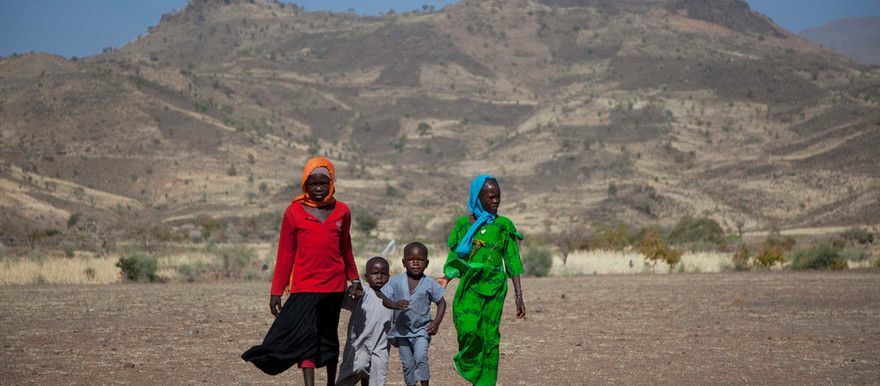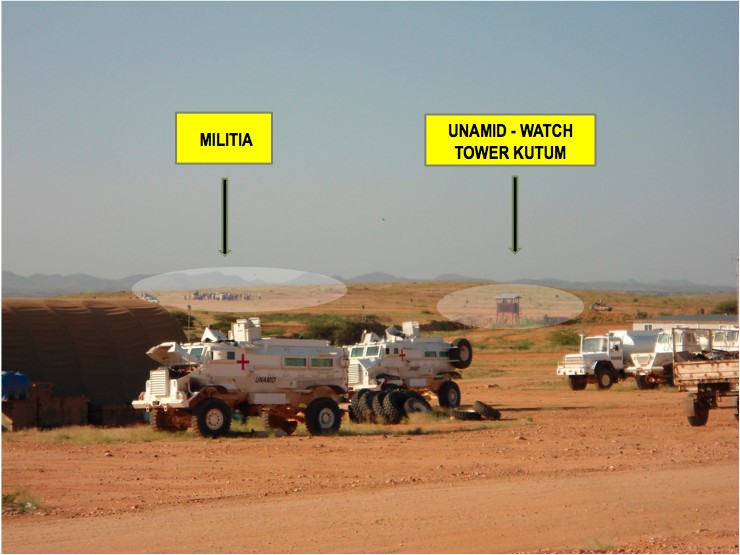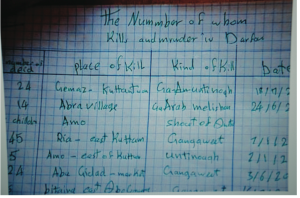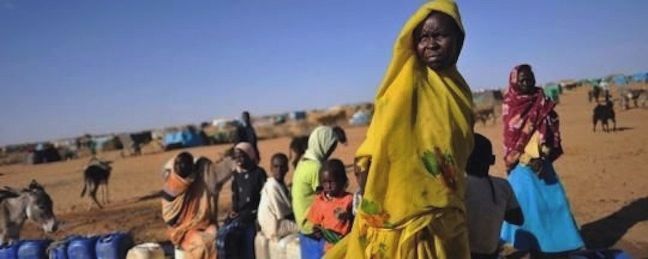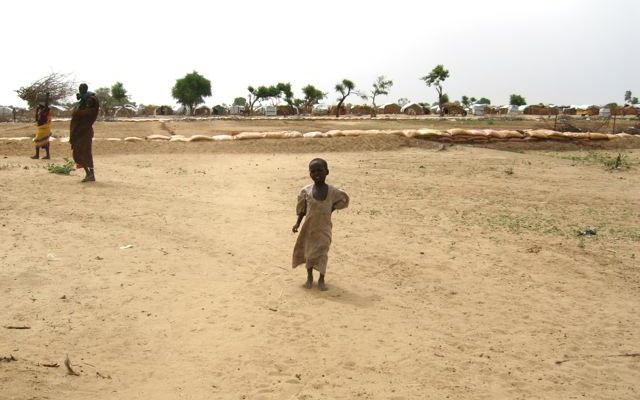Approximately 500,000 people were newly displaced in Darfur in 2014—and this year promises to be worse.
The total number of civilians newly displaced since the deployment of the UN/African Union Mission in Darfur (UNAMID) in January 2008 is now well over 2 million. The current UN Security Council authorization of the mission runs only through June 2015, and Khartoum has demanded that the UN Department of Peacekeeping Operations expeditiously draw up plans for the withdrawal of the mission. The future looks unspeakably grim for the region.
UN High Commission for Refugees (UNHCR) estimate for human displacement throughout Darfur: January to August 2015: (January 2015 | http://www.unhcr.org/pages/49e483b76.html )
The humanitarian environment in Sudan has deteriorated over the past two years, with new, conflict-induced internal displacement in Darfur. About 400,000 new internally displaced people (IDPs) were registered [N.B.] between January and August 2014 in the country.
Estimates of the number of people newly displaced between August and December 2014 vary, but it is clear the number exceeds 50,000, perhaps 100,000. The New York Times in a dispatch of 25 December 2014 used a figure of 457,000 newly displaced in 2014. But the situation on the ground, especially in North Darfur, is so violent that many people who fled in November and December will not be reflected in any official UN figures. Certainly not all people displaced make their way to camps where they can be registered for food aid; and the IDP camps are themselves increasingly inaccessible to humanitarian organizations. This was the primary reason Doctors Without Borders/Médecins Sans Frontières (MSF)-Belgium gave for suspending operations in South and East Darfur (January 29, 2015 | http://wp.me/p45rOG-1A0 ).
Since the UN/African Union Mission in Darfur (UNAMID) officially deployed in January 2008, well over 2 million Darfuris have been newly displaced. As it has for the entire conflict, displacement and violence correlate to an extremely high degree. The Mission has failed terribly in fulfilling its primary mandate of civilian protection.
Many of the victims of violence are unable to move because of military threats from the Rapid Support Forces (RSF). Radio Dabanga reports (25 December 2014):
[The] Rapid Support Forces (RSF) are stationed with more than 200 vehicles north of Hilla El Jedida, north of Shangil Tobaya. The troops have imposed a blockade on the region since Monday, preventing villagers from fleeing East Jebel Marra towards Shadad and Naivasha camps for the displaced. RSF troops also prevented people from going out to welcome the newly displaced people, the listener reported. This happened on Thursday when a number of displaced people came out to welcome seven families who just fled Shagaragi in East Jebel Marra. The families consisted mostly out of women and children. They remain out in the open near Shadad camp since Tuesday, without water, food, and shelter, the listener added.
It is also the case that the brutality of displacement in the harsh environment of Darfur has been too little considered in estimating displacement. Many of those forced to flee their villages over the past twelve years were unable to make it to a camp to be registered because they died en route. In other words, the massive mortality that has occurred during often arduous flights to safety is reflected nowhere in UN figures for displacement. Moreover, the UN has not offered any mortality data since a crude estimate of “300,000” in 2008 but then Under-secretary for Humanitarian Affairs John Holmes. The data available suggest that more than 500,000 have died over the past twelve years of genocidal counter-insurgency war as conducted by the Khartoum regime (http://wp.me/p45rOG-AB ). Those displaced, and who die as a consequence of flight, obviously do not figure in the estimates of total displacement.
Darfuri refugees in eastern Chad doing their best to reconstruct mortality totals for their villages
It is also important to remember that the UN figures for displaced persons are only for those who remain in Darfur, and do not include refugees. But the Darfuri refugee population in eastern Chad has increased significantly in the past couple of extraordinarily violent years, and now stands at approximately 370,000 according to the UNHRC.
Refugees in eastern Chad—some of whom have lived in forced exile for more than a decade
[ For a retrospective account of displacement data for Darfur since 2007, see “Taking Human Displacement in Darfur Seriously,” Sudan Tribune, 3 June 2013 ]
The most recent reports from the UN Office for the Coordination of Humanitarian affairs gives some sense of how 2015 has begun in its Humanitarian Bulletin covering January 5 – 11, 2015:
People flee their homes in the Jebel Marra area
The UN has received various reports of new civilian displacement following fighting between government forces and armed movements in parts of the Jebel Mara area in Central Darfur State as well as in Tawila locality in North Darfur State in late December 2014 and early January 2015. While these reports indicate that thousands of people may have been displaced, international aid organisations are unable to verify these reports because they cannot access most of the affected areas and affected/displaced people due to the prevailing security situation in those areas…
While the majority of the affected people were reportedly displaced within North Jebel Marra locality, there are indications that some affected people may have moved to IDP camps in Tawila locality, Zamzam camp and Shangil Tobaya area, all in North Darfur. Once registration and verification of these newly displaced people in those camps and areas is completed more detailed information on the origins and numbers of those new arrivals will be provided.
Aid agencies verify about 5,700 new IDPs from Tawila, North Darfur.
Attacks by unidentified armed militias on a number of villages in North Darfur’s Tawila locality early this month has led to the displacement of 5,700 people, according to preliminary findings of an inter-agency assessment mission to the Tawila area between 10 and 12 January 2015. All these verified displaced people need shelter materials, emergency household supplies, food and access to safe water. Amongst those verified are 975 people who arrived in Rwanda camp from Tangoro, Umsiala and Gafena villages. A further 4,715 people arrived in Argo IDP camp from the villages of Martal, Dolma, Gozdoor, Tordibilo, Saemo, Jonsi, Arberti, Um Syala, Wadi Tasdir, Hillat Zubeir, Hillat Tamaro, Hillat Albira villages in Tawilla locality and Fanga Souk village in Rokoro locality of Central Darfur.
The following issue of OCHA’s Humanitarian Bulletin for Sudan (January 12 – 18, 2015) indicates more grim news about displacement:
Numbers of verified newly displaced people in North Darfur State: 18,392
And again, we must remember—as the very precision of this figure indicates—these are only those who have been “verified.” In the growing violence and chaos, particularly in North Darfur, verification becomes an increasingly difficult and dangerous task. If we depend only upon numbers of displaced persons that have been verified, we are seriously under-counting the actual figure.
Ad the most recent Bulletin for Sudan (January19 – 25, 2015) provides an even grimmer update:
Close to 21,000 new IDPs verified in North Darfur
More people are fleeing their homes as a result of ongoing fighting between Government forces and armed movements in parts of Darfur. Humanitarian organisations have assessed and verified more than 20,700 new internally displaced persons (IDPs) in North Darfur State who fled their homes since December 2014. This figure is expected to increase further as reports received from Um Baru locality in North Darfur indicate a considerable increase in the number of new IDPs seeking shelter near the United Nations – African Union Mission in Darfur (UNAMID) Um Baru base.
Agencies unable to access new IDPs in Jebel Marra Moreover, aid agencies have received reports that many more people have been displaced in the northern parts of Jebel Marra, but have not been able to verify these reports due to access constraints and ongoing fighting in the area. Local authorities, humanitarian organisations and UNAMID in Nertiti town, Central Darfur State reported that some people from the surrounding villages of Baldong, Kenga, Kiwala and Kutrum were seen moving their valuables and property to Nertiti town.
However, humanitarian organizations in Nertiti have not yet established the number of people that have so far moved in and/or where they have settled. There are also unconfirmed reports that some people are moving away from Nertiti to Zalingei town in Central Darfur and Kass and Nyala town in South Darfur.
In North Darfur, 20,700 verified new IDPs and another 2,900 unverified new IDPs received some form of assistance.
There are countless orphans who have been created by the violent splitting apart of families; their future is unclear and likely desperate.
